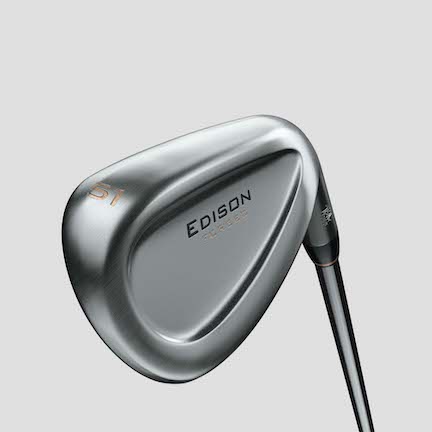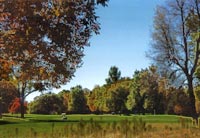Terry Koehler has been in the golf equipment industry for 40 years. He began with Ray Cook Putters in the early 1980s. He joined Ben Hogan Golf in the early 90s. He founded both Eidolon Golf and Scor Wedges, where he developed the first progressive weight wedge system. Then he brought Ben Hogan back to life. He planned to retire and write as “The Wedge Guy.”

But Koehler felt he had some unfinished business. So he founded Edison Wedges. What makes Edison Wedges different from the wedges of big-name companies? In a recent interview, Koehler opined about Edison, wedges in general, and what average golfers need in their wedges.
Terry Kohler: In all major companies’ wedges, the top two-thirds of the clubhead in most wedges is thin. The biggest wedge mis-hit for most amateurs is high on the face. The smash factor decreases dramatically when impact is above the 5th groove. Spin decreases, too. 87% of spin on full shots comes from wedge weighting; only 13% comes from the grooves. The gear effect is also accentuated because the weight is below the ball. So most amateurs hit wedges too high, offline, and with not enough spin.
Kiel Christianson: What’s keeping major manufacturers from making wedges for average golfers?
TK: They make wedges for their tour pros. Wedges are the only clubs that don’t have many game-improvement elements. Less than 2% of recreational golfers play blades as their irons, but 98% play wedges designed for pros. Impact is optimized between grooves 2-5. This is where pros hit it. Average players usually contact the ball between grooves 4-8. Edison wedges are built for center of impact between grooves 3-8. This is what 8-20 handicappers need. All companies are trying to sneak weight higher in the face, but hampered by what tour players will let them do. Iron Byron proves what is good for pros is not appropriate for the vast majority of recreational players.
KC: What about those wide-soled, anti-chunk wedges?
TK: I call those one-hit wonders. They’re good for getting out of the sand, but not for full shots or creating shots around the green. Nobody knows what their next lie is going to look like, or what the conditions will be. When I looked around at wedges on the market, I said, “For Pete’s sake, let’s build a sole that will work in all conditions.”
KC: So what features of Edison Wedges are specially designed for average golfers?
TK: Edison has more weight above impact than anyone has ever done before, and they’re forged. The top section is 34% heavier than low section – this makes for a more penetrating flight and more spin. Testing shows that Edison wedges without the grooves cut in yet produce more spin on a dry ball than our competitors’ grooved wedges. Again, grooves only account for 13% of the spin equation. On short shots around greens, grooves matter more.
KC: Do they look chunkier at set-up?
TK: Our wedges are obviously thicker from back or in cross-sections – about 2x as thick on top half of the clubface than big-name wedges. At address the topline is slightly thicker, but not distracting.
How Edison Wedges play
The Edison Wedges website features a Wedgefit page, where shoppers can enter information about their game, tendencies, and current wedges. Koehler personally inspected my profile, and set me up with a three-wedge set: 49-deg., 53-deg., and 59-deg ($184 each). The lofts were somewhat surprising when I opened the box, as I usually play a 52, 56, and 60 set. And, importantly, I know precisely what my yardages are with these lofts.
Nevertheless, I took the Edisons to my local course (and some not-so-local ones) to play them for ten rounds. I remember quite clearly what I thought when I hit my first shot with one, too: “Wow—Koehler wasn’t kidding.”
You can feel immediately that Edison Wedges are forged, as they feel rock-solid yet exquisitely soft. The soles have worked perfectly in both the sloppy early-spring conditions and now in what has become a very dry early summer. Bunker shots with both the 53 and 59 have been better than ever – I got up and down for three rather improbable pars at Fyre Lake Golf Course from some very deep greenside bunkers with the 59, despite being short-sided every time.
Not only is the feel of Edison Wedges fabulous, but as Koehler described, the ball flight is generally lower than most wedges, and the ball spins more. I have “backed up” these wedges more than ever before (except, perhaps, Koehler’s old Scor Wedges, which I also reviewed).
The only downside to the wedge set are the yardages of the unfamiliar lofts. The 49-deg. Edison traveled considerably farther than my old 52-deg., about the same as a soft pitching wedge. So it was difficult to figure out how hard to swing for a standard 125 yard “gap” wedge. The same went for the 53-deg., which required trying to swing softer to hit my normal 100-110 56-deg. yardage. As a result, I found myself over the back of more greens during those ten rounds than I recall all last season.
On the other hand, I had given up trying to hit full 60-deg. wedges, as they often came out soft and right because they were contacted so high on the face. Edison’s weighting has put an incredible 80-yard full-swing option into my bag. In fact, the 59-deg. now gets the call for any shot less than 80 yards.
The verdict
If you’re not a pro golfer, and if you struggle with your wedges, Edison is well worth a try. According to Koehler, most Edison customers come for one wedge to try them out first, “And they come back for a whole set after a round or two.”
“I’ve got Iron Byron data from 60,000 average golfers,” says Koehler. “There’s not another wedge on the market that’s built like Edison.”
In other words, they were invented specifically with players like you—and me—in mind.
